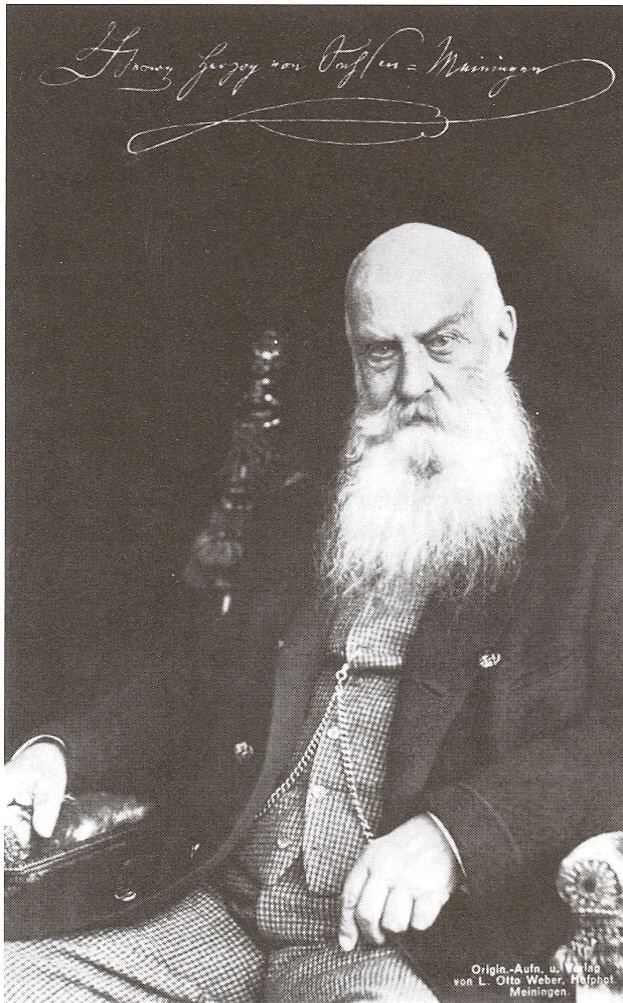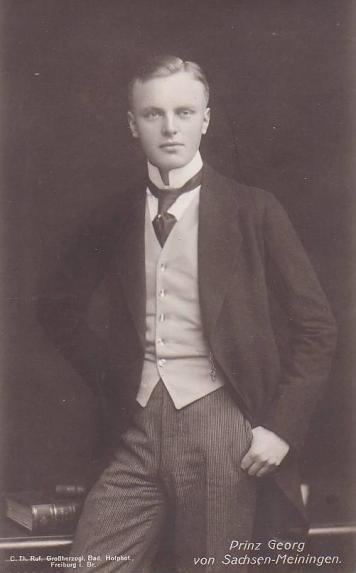Flag Coat of arms Government Principality Area 2,468 km² Date dissolved 1918 | Founded 1680 | |
 | ||
Princess adelaide of saxe meiningen queen of the united kingdom
Saxe-Meiningen (/ˈsæks ˈmaɪnɪŋən/; [ˈzaksən ˈmaɪnɪŋən]) was one of the Saxon duchies held by the Ernestine line of the Wettin dynasty, located in the southwest of the present-day German state of Thuringia.
Contents
- Princess adelaide of saxe meiningen queen of the united kingdom
- Feodora of saxe meiningen princess heinrich xxx of reuss k stritz
- House of Wettin
- Duchy of Saxe Meiningen
- End of the Duchy
- Dukes of Saxe Meiningen
- Heads of the Ducal House of Saxe Meiningen post monarchy
- References

Established in 1681, by partition of the Ernestine duchy of Saxe-Gotha among the seven sons of deceased Duke Ernst der Fromme (Ernest the Pious), the Saxe-Meiningen line of the House of Wettin lasted until the end of the German monarchies in 1918.

Feodora of saxe meiningen princess heinrich xxx of reuss k stritz
House of Wettin

The Wettiner had been the rulers of sizeable holdings in today's states of Saxony, Saxony-Anhalt and Thuringia since the Middle Ages. In the Leipziger Teilung of 1485, the Wettiner were split into two branches named after their founding princes Albrecht and Ernst (albertinisch and ernestinisch). Thuringia was part of the Ernestine holdings of Kursachsen (the Electoral holdings of Saxony). In 1572, the branches Saxe-Coburg-Eisenach and Saxe-Weimar were established there. The senior line again split in 1641/41 into three duchies, including the Duchy of Saxe-Gotha.

Duke Ernst I who founded this duchy with its seat at Gotha opposed the system of primogeniture. As a result, on his death in 1675 all of his sons inherited part of his holdings and were supposed to rule under the leadership of his oldest son. In practice, this proved very complicated and brought on three settlements in 1679, 1680 and 1681 that established the following princedoms: Saxe-Gotha (Friedrich), Saxe-Coburg (Albrecht), Saxe-Meiningen (Bernhard), Saxe-Eisenberg (Christian), Saxe-Hildburghausen (Ernst) and Saxe-Saalfeld (Johann Ernst).
Duchy of Saxe-Meiningen
Bernhard, Ernst I third son, received the town of Meiningen as well as several other holdings (Wasungen und Salzungen, Maßfeld und Sand, Herrenbreitungen, Herpf, Stepfershausen, Utendorf, Mehlis and the former Franconian lands of the extinct House of Henneberg, Henneberg).
Bernhard chose the town of Meiningen as his residence and became the first Duke of Saxe-Meiningen. From 1682 Duke Bernhard I had the Schloss Elisabethenburg built and in 1690 established a court orchestra (Hofkapelle), in which Johann Ludwig Bach later became the Kapellmeister (1711).
In the reshuffle of Ernestine territories that occurred following the extinction of the Saxe-Gotha-Altenburg line upon the death of Duke Friedrich IV in 1825, Duke Bernhard II of Saxe-Meiningen received the lands of the former Duchy of Saxe-Hildburghausen as well as the Saalfeld territory of the former Saxe-Coburg-Saalfeld duchy.
As Bernhard II had supported Austria in the 1866 Austro-Prussian War, the prime minister of victorious Prussia, Otto von Bismarck, enforced his resignation in favour of his son Georg II, after which Saxe-Meiningen was admitted to join the North German Confederation.
By 1910, the Duchy had grown to 2,468 km² and 278,762 inhabitants. The ducal summer residence was at Altenstein Castle. Since 1868, the duchy comprised the Kreise (districts) of Hildburghausen, Sonneberg and Saalfeld as well as the northern exclaves of Camburg and Kranichfeld.
End of the Duchy
In the German Revolution after World War I, Duke Bernhard III, brother-in-law of Emperor Wilhelm II, was forced to abdicate and his oldest son Ernst on 11/12 November 1918 refused the succession. The succeeding "Free State of Saxe-Meiningen" was merged into the new state of Thuringia on 1 May 1920.
As of 2012 the head of the Ducal House of Saxe-Meiningen, Prince Konrad (born 1952), has no children, so the representation of his house will pass to his half brother Friedrich Ernst's (1935–2004) son Prince Constantin (born 1980).
Dukes of Saxe-Meiningen
Notes:
